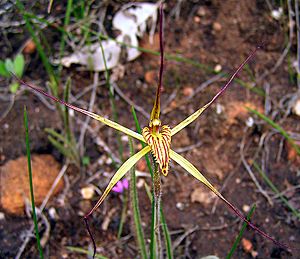Mustard spider orchid facts for kids
The mustard spider orchid (scientific name: Caladenia caesarea subsp. caesarea) is a special kind of orchid that grows only in the south-west part of Western Australia. It gets its name from its unique mustard-yellow flowers that have red stripes, making them look a bit like a spider. This orchid was once thought to be a subspecies of another orchid. However, its rich flower color and a special part called the labellum helped scientists realize it was its own distinct species.
Quick facts for kids Mustard spider orchid |
|
|---|---|
 |
|
| Scientific classification |
|
| Kingdom: | Plantae |
| Clade: | Tracheophytes |
| Clade: | Angiosperms |
| Clade: | Monocots |
| Order: | Asparagales |
| Family: | Orchidaceae |
| Subfamily: | Orchidoideae |
| Tribe: | Diurideae |
| Genus: | Caladenia |
| Species: |
C. caesarea
|
| Subspecies: |
C. c. subsp. caesarea
|
| Trinomial name | |
| Caladenia caesarea subsp. caesarea |
|
Contents
What Does the Mustard Spider Orchid Look Like?
The mustard spider orchid is a ground-dwelling plant. It is also a perennial plant, meaning it lives for more than two years. It's a deciduous herb, which means its leaves fall off at certain times.
This orchid has an underground tuber (like a small potato) that stores food. A single, hairy leaf grows upright from the ground. This leaf is usually about 12 to 18 centimeters (5-7 inches) long. It is also quite narrow, about 2 to 4 millimeters (0.08-0.16 inches) wide.
The plant produces up to three flowers on a stem. This stem can grow to be about 20 to 35 centimeters (8-14 inches) tall. Each flower is quite large, measuring about 5 to 10 centimeters (2-4 inches) long. They are also about 6 to 7 centimeters (2.4-2.8 inches) wide.
The side parts of the flower, called the lateral sepals and petals, stand out stiffly. They spread widely, giving the flower its spider-like look. The most striking part is the labellum, which is mustard-yellow. It has brownish-red stripes and sticks out prominently. The edge of the labellum is jagged or irregularly serrated. It also has two rows of shiny yellow bumps, called calli, running down its center.
Life Cycle and Flowering Time
Mustard spider orchids usually bloom between September and November. After the flowers fade, they form a dry capsule. This capsule is not fleshy and splits open when ripe. It releases a large number of tiny seeds, which helps the orchid reproduce.
How Did the Mustard Spider Orchid Get Its Name?
The mustard spider orchid was first officially described in 1912. A scientist named Karel Domin gave it the name Caladenia filamentosa subsp. caesarea. This description was published in a science journal called Journal of the Linnean Society, Botany.
Later, in 1989, two other scientists, Mark Clements and Stephen Hopper, decided it was unique enough to be its own species. They changed its status to Caladenia caesarea. Then, in 2001, Hopper and Andrew Brown described three different types, or subspecies, of this orchid. One of these was the subspecies caesarea, which is the mustard spider orchid we are talking about. Their descriptions were published in the journal Nuytsia.
The special part of its scientific name, caesarea, comes from a Latin word. It means "emperor" or "ruler." This name was chosen because the flowers are considered "stately" and very attractive.
Where Does the Mustard Spider Orchid Live?
The mustard spider orchid grows in the very south-west corner of Western Australia. You can find it in an area between Boyup Brook and the Stirling Range. This region includes different natural areas like the Avon Wheatbelt, Jarrah Forest, and Mallee biogeographic regions.
It prefers to grow in damp or swampy areas. You can often find it in forests where wandoo (a type of eucalyptus tree) and jarrah (another eucalyptus tree) grow.
Is the Mustard Spider Orchid Safe?
The Western Australian Government's Department of Parks and Wildlife keeps track of plants and animals. They have classified Caladenia caesarea subsp. caesarea as "not threatened." This means that, for now, there are enough of these beautiful orchids in the wild, and they are not considered to be in danger.

